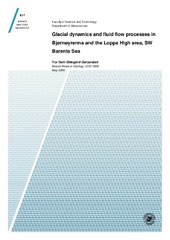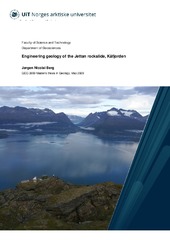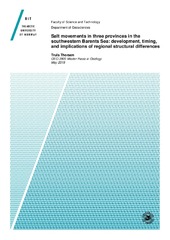Institutt for geovitenskap: Recent submissions
Now showing items 521-540 of 1121
-
Glacial dynamics and fluid flow processes in Bjørnøyrenna and the Loppa High area, SW Barents Sea
(Master thesis; Mastergradsoppgave, 2020-05-15)During the Late Weichselian glaciation, the Bjørnøyrenna ice stream was the main outlet of the Barents Sea Ice Sheet. In this thesis, a 3D seismic dataset from the Loppa High, located in the main ice stream trunk, has been used to study the glacial sediment package, revealing details on pastglacial dynamics, fluid flow processes and gas hydrate formation. Three seismic horizons have been interpreted: ... -
Engineering geology of the Jettan rockslide, Kåfjorden
(Master thesis; Mastergradsoppgave, 2020-05-15)The unstable rock slope (URS) Jettan is located at Nordnesfjellet in Kåfjorden municipality in Troms and Finnmark County, 800 m above the fjord. The rockslide has an estimated volume of 6 Mm3, and moving at a rate of up to 50 mm a-1. Jettan is considered a “high risk object” within the Norwegian unstable mountain framework. This is due to the potential displacement wave impact to housings, infrastructure ... -
Innovative methods to monitor rock and mountain slope deformation
(Journal article; Tidsskriftartikkel; Peer reviewed, 2020-02-17)Displacement rates of mountain slope deformations that can affect entire valley mountain flanks are often measured spatially distributed in‐situ without spatial significance. The spatially explicit measurement and recording of time series of slope deformations is a challenge, as the unstable slopes are often disintegrated into several subdomains, which move with different deformation rates. The ... -
Geochemical evidence for seabed fluid flow linked to the subsea permafrost outer border in the South Kara Sea
(Journal article; Tidsskriftartikkel; Peer reviewed, 2019-04-16)Driven by rising bottom water temperatures, the thawing of subsea permafrost leads to an increase in fluid flow intensity in shallow marine sediments and results in the emission of methane into the water column. Limiting the release of permafrost-related gas hydrates and permafrost- sequestered methane into the global carbon cycle are of primary importance to the prevention of future Arctic Ocean ... -
The relationship between shallow anomalies and gas-flaring on the flank of the Nordkapp Basin in the SE Barents Sea
(Master thesis; Mastergradsoppgave, 2020-05-18)This study investigates the north-east-subbasin of the Nordkapp Basin in the Barents Sea. Main focus has been on mapping shallow seismic anomalies from 3D data, their potential association with faulting and sub-surface structures, and further to compare the occurrence of seismic anomalies to possible gas-flares above the seabed from water column data. The stratigraphic intervals from Triassic to ... -
Last Glacial Maximum – Holocene palaeoenvironment in Bessel Fjord and southwestern Dove Bugt, Northeast Greenland
(Master thesis; Mastergradsoppgave, 2020-05-14)Marine studies reconstructing ice sheet conditions on the Northeast Greenland shelf and adjacent fjords since the Last Glacial Maximum (LGM) are sparse. As a result, the timing and origin of the deglaciation of the ice sheet over marine areas is not well constrained. This thesis aims to improve our understanding of the LGM, deglaciation, and Holocene ice dynamics of the Greenland Ice Sheet (GrIS) ... -
Late Quaternary glacier and sea-ice history of northern Wijdefjorden, Svalbard
(Journal article; Tidsskriftartikkel; Peer reviewed, 2020-04-10)The deglaciation history and Holocene environmental evolution of northern Wijdefjorden, Svalbard, are reconstructed using sediment cores and acoustic data (multibeam swath bathymetry and sub‐bottom profiler data). Results reveal that the fjord mouth was deglaciated prior to 14.5±0.3 cal. ka BP and deglaciation occurred stepwise. Biomarker analyses show rapid variations in water temperature and sea ... -
Global temperature calibration of the Long chain Diol Index in marine surface sediments
(Journal article; Tidsskriftartikkel; Peer reviewed, 2020-02-07)The Long chain Diol Index (LDI) is a relatively new organic geochemical proxy for sea surface temperature (SST), based on the abundance of the C<sub>30</sub> 1,15-diol relative to the summed abundance of the C<sub>28</sub> 1,13-, C<sub>30</sub> 1,13- and C<sub>30</sub> 1,15-diols. Here we substantially extend and re-evaluate the initial core top calibration by combining the original dataset with 172 ... -
Analyse av strukturer og bevegelsesdata i det ustabile fjellskredområdet Gámmanjunni 3, Kåfjord kommune, Troms og Finnmark fylke. Med vekt på kontrollerende faktorer, skråningsprosesser, bevegelsesdynamikk og skredmodeller.
(Master thesis; Mastergradsoppgave, 2020-05-15)Gámanjunni 3 er et av de ustabile fjellpartiene i Norge med høyest bevegelseshastighet. Hovedmålet med studiet er å sammenstille gamle og nye feltdata, bevegelsesdata og geofysiske data fra tidligere studier ved Gámanjunni 3 til en helhetlig geologisk modell i 3D, og undersøke hvilke interne og eksterne faktorer som kontrollerer fjellpartiet. I tillegg skal det fokuseres på bevegelsesdynamikk, ... -
Stratigraphy, neo-tectonics and mass wasting of deep water drifts in the Fram Strait
(Master thesis; Mastergradsoppgave, 2020-05-15)The primary goal for this thesis was the reprocessing and interpretation of 2D seismic lines in the Fram Strait and West Svalbard Margin (WSM). Seismic data quality was significantly improved through the implementation of new processing steps that had previously not been applied, incl. e.g. burst removal and a more advanced type of migration. The reprocessed lines were acquired by CAGE over multiple ... -
Late Devonian–Carboniferous faulting and controlling structures and fabrics in NW Finnmark
(Journal article; Tidsskriftartikkel; Peer reviewed, 2019-09-10)In the SW Barents Sea, Devonian–Carboniferous collapse led to the formation of major basins and faults, e.g., the Hammerfest Basin bounded by the Troms–Finnmark Fault Complex, and rhomboid- to sigma-shaped (half-)grabens on the Finnmark Platform. High-resolution aeromagnetic and bathymetry data from the shallow shelf show that analogue fault systems are present in coastal and onshore areas of NW ... -
Ice-sheet Dynamics and Postglacial Sedimentary Processes of Coastal Søre Sunnmøre, Southwest Norway
(Master thesis; Mastergradsoppgave, 2020-05-15)Submarine glacial landforms have been identified and mapped in order to reconstruct ice sheet dynamics and to describe postglacial sedimentary processes of coastal Søre Sunnmøre in southwestern Norway which lies between 62 and 62.5⁰N. Landform identification has been accomplished through analysis of high-resolution multibeam echosounder (MBES) bathymetric data, backscatter data, LiDAR data, video ... -
Fluid flow and faulting along the northern margin of the Loppa High
(Master thesis; Mastergradsoppgave, 2020-05-15)The Barents Sea is a large epicontinental sea and petroliferous basin, which is fairly unexplored compared to other regions of the Norwegian Continental Shelf (NCS). The structural configuration of the SW Barents Sea is characterized by a complex mosaic of structural highs, platforms and basins, reflecting the interplay between multiple tectonic phases. Late Cenozoic glacially induced subsidence and ... -
Microbial communities from Arctic marine sedimentsrespond slowly to methane addition duringex situenrichments
(Journal article; Tidsskriftartikkel; Peer reviewed, 2019-12-15)Anaerobic methanotrophic archaea (ANME) consume methane in marine sediments, limiting its release to the water column, but their responses to changes in methane and sulfate supplies remain poorly constrained. To address how methane exposure may affect microbial communities and methane‐ and sulfur‐cycling gene abundances in Arctic marine sediments, we collected sediments from offshore Svalbard that ... -
Geological controls of giant crater development on the Arctic seafloor
(Journal article; Tidsskriftartikkel; Peer reviewed, 2020-05-21)Active methane seepage occurs congruent with a high density of up to 1 km-wide and 35 m deep seafloor craters (>100 craters within 700 km<sup>2</sup> area) within lithified sedimentary rocks in the northern Barents Sea. The crater origin has been hypothesized to be related to rapid gas hydrate dissociation and methane release around 15–12 ka BP, but the geological setting that enabled and possibly ... -
Is there a Climatic Control on Icelandic Volcanism?
(Journal article; Tidsskriftartikkel; Peer reviewed, 2020-05-07)The evidence for periods of increased volcanic activity following deglaciation, such as following ice sheet retreat after the Last Glacial Maximum, has been examined in several formerly glaciated areas, including Iceland, Alaska, and the Andean Southern Volcanic Zone. Here we present new evidence supporting the theory that during episodes of cooling in the Holocene, Icelandic volcanic activity ... -
Biogeochemical Consequences of Nonvertical Methane Transport in Sediment Offshore Northwestern Svalbard
(Journal article; Tidsskriftartikkel; Peer reviewed, 2020-03-21)A site at the gas hydrate stability limit was investigated offshore northwestern Svalbard to study methane transport in sediment. The site was characterized by chemosynthetic communities (sulfur bacteria mats, tubeworms) and gas venting. Sediments were sampled with in situ porewater collectors and by gravity coring followed by analyses of porewater constituents, sediment and carbonate geochemistry, ... -
Late Cenozoic erosion in the SW Barents Sea, and its influence on salt movement
(Master thesis; Mastergradsoppgave, 2019-05-15)The late Cenozoic evolution of the southwestern Barents Sea shelf includes periods of uplift, erosion and glaciations. This part of the stratigraphy has been studied using 2D and 3D seismic data, with emphasis on the interplay between uplift, erosion and glaciations and salt movement. The study area comprises the Svalis, Samson and Norvarg domes and the Nordkapp Basin, where halokinesis has been a ... -
Salt movements in three provinces in the southwestern Barents Sea: development, timing, and implications of regional structural differences
(Master thesis; Mastergradsoppgave, 2019-05-15)This study has investigated salt movements in the Nordkapp Basin, on the Loppa High (Svalis Dome) and on the Bjarmeland Platform (Samson- and Norvarg domes). The aim is to discuss how differences in salt growth potentially relates to the structural evolution of - and differences between - these three provinces. Evaluation of seismic 2D- and 3D data together with well correlation, allowed a regional ... -
Structurally controlled rock slope deformation in northern Norway
(Journal article; Tidsskriftartikkel; Peer reviewed, 2020-05-11)Gravitational forcing of oversteepened rock mass leads to progressive failure, including rupture, creeping, sliding and eventual avalanching of the unstable mass. As the point of rupture initiation typically follows pre-existing structural discontinuities within the rock mass, understanding the structural setting of slopes is necessary for an accurate characterisation of the hazards and estimation ...


 English
English norsk
norsk


















